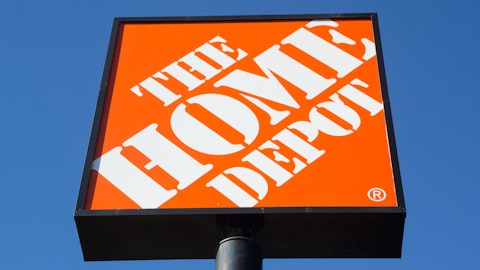Dividend Analysis
We analyze 25+ years of dividend data and 10+ years of fundamental data to understand the safety and growth prospects of a dividend. Home Depot’s long-term dividend and fundamental data charts can all be seen by clicking here.
Dividend Safety Score
Our Safety Score answers the question, “Is the current dividend payment safe?” We look at factors such as current and historical EPS and FCF payout ratios, debt levels, free cash flow generation, industry cyclicality, ROIC trends, and more. A score of 50 is average, 75 or higher is very good, and 25 or lower is considered weak.
Home Depot Inc (NYSE:HD)’s Dividend Safety Score of 74 is excellent and indicates that the company pays one of the safest dividends in the market.
The company’s strong safety rating begins with its conservative payout policy. Home Depot targets a dividend payout ratio of 50% of earnings with a goal of increasing its dividend every year.
The company’s payout ratio over the last 12 months is 55%, essentially in line with management’s target. Over a longer period of time, we can see that Home Depot’s payout ratio has increased from the mid-teens in 2005 to sit closer to 40% in recent years.
A payout ratio of 50% provides a good margin of safety for most businesses. Even if earnings unexpectedly fell by 30%, the company’s payout ratio would still be below 70%.

Source: Simply Safe Dividends
Another factor impacting dividend safety is how well a company performed during the last recession, which served as the ultimate stress test for many businesses.
As seen below, Home Depot’s sales fell at a mid- to upper-single digit rate in fiscal years 2009 and 2010. The housing market obviously performed much worse than that, so Home Depot held up better than one might have expected.
Despite its moderate sales declines, earnings and free cash flow per share each declined by more than 25%. Home Depot incurs substantial fixed costs due to the nature of its store base, resulting in operating leverage.
Management held Home Depot’s dividend flat during the financial crisis. While the company is sensitive to the economy and housing market, its mix of repair products and services help it endure difficult market environments.

Source: Simply Safe Dividends
Return on invested capital is one of the most important financial ratios for dividend investing because it can be a good indicator of business quality. Companies with strong competitive advantages will usually earn high and stable returns, allowing them to compound earnings faster and pay safer dividends.
Home Depot significantly improved its return on invested capital since the housing crash, increasing it from 8% in fiscal year 2009 to 26% last fiscal year. Home Depot is clearly a very efficient and profitable operator.

Source: Simply Safe Dividends





